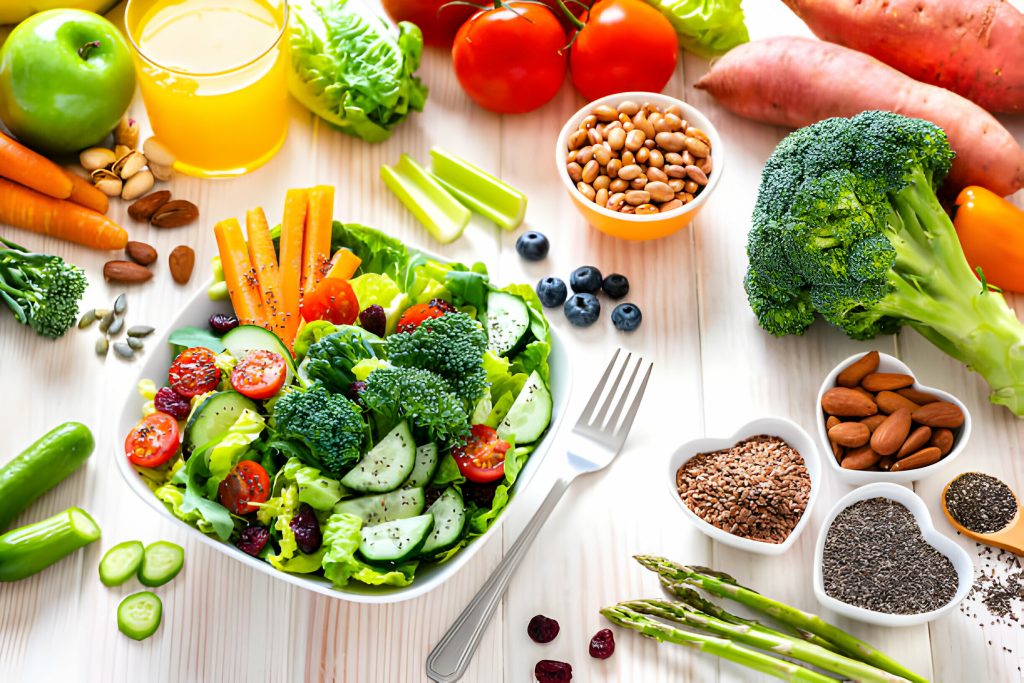Do you want to know how to fuel your body with high fiber foods while following the Paleo diet? Well, look no further! In this article, we will dive into the world of fiber and explore its importance in maintaining a healthy lifestyle. You’ll discover the benefits of incorporating fiber-rich foods into your Paleo meal plan, learn about different types of fiber, and get practical tips for boosting your fiber intake. Get ready to nourish your body from within and optimize your overall well-being on a Paleo diet.
The Benefits of High Fiber Foods for Paleo
High fiber foods are beneficial for a paleo diet because they lower inflammation, reduce the risk of heart disease, boost metabolism, aid in weight maintenance, and support a healthy gut and immune system. Fiber plays a crucial role in stabilizing blood sugar levels by slowing down the absorption of glucose into the bloodstream. This helps prevent spikes and crashes in energy levels throughout the day. Additionally, fiber promotes satiety, making you feel fuller for longer periods of time and reducing overeating. It also helps to lower cholesterol levels by binding to bile acids in the digestive tract and preventing their reabsorption. Furthermore, fiber supports a healthy immune system by providing nourishment for beneficial gut bacteria, which play a key role in immune function. Lastly, fiber can boost metabolism by increasing thermogenesis, which is the process of burning calories to produce heat. Incorporating high fiber foods into your paleo diet is essential for overall health and well-being.
Types of Fiber and Their Importance in a Paleo Diet
Including a variety of fruits, vegetables, nuts, and seeds in your diet can provide you with different types of fiber that are important for a paleo lifestyle. Fiber plays a crucial role in digestion and overall health. It aids in maintaining a healthy gut by promoting regular bowel movements and preventing constipation. Additionally, fiber-rich foods help to manage weight by increasing satiety and reducing calorie intake. Some examples of fiber-rich foods for gut health include cruciferous vegetables like broccoli and cauliflower, greens such as spinach and kale, nuts like almonds and walnuts, seeds like chia seeds and flaxseeds, as well as beans and legumes. By naturally increasing your fiber intake through these food sources, you can support optimal digestion, improve gut health, and manage your weight effectively on a paleo diet.
Paleo-Friendly Sources of Soluble Fiber
One good source of soluble fiber in a paleo diet is cruciferous vegetables like broccoli and cauliflower. These vegetables not only provide essential nutrients but also offer numerous benefits for your overall health, including gut health and cholesterol management. Soluble fiber has been shown to lower LDL cholesterol levels, reducing the risk of heart disease. Incorporating more soluble fiber into your paleo diet can be as simple as adding these vegetables to your meals or enjoying them as snacks. Additionally, you can explore fiber-rich snack options such as nuts and seeds, which are also excellent sources of soluble fiber. For a refreshing twist, try incorporating soluble fiber into your diet with paleo-friendly smoothie recipes that include ingredients like chia seeds and flaxseeds. By prioritizing these high-fiber foods in your paleo diet, you can enjoy the benefits they provide for both your gut health and overall well-being.
| Benefits of Soluble Fiber | Paleo Diet and Cholesterol | Fiber Rich Snacks |
|---|---|---|
| Lowers LDL cholesterol | Supports heart health | Nuts |
| Reduces the risk of | Seeds | |
| heart disease | ||
| Promotes healthy | ||
| blood sugar levels |
Paleo Fiber Smoothie Recipes
- Green Power Smoothie:
- Ingredients: spinach, avocado, chia seeds.
- Blend until smooth.
- Berry Blast Smoothie:
- Ingredients: mixed berries (strawberries, blueberries), flaxseeds.
- Blend until well combined.
- Tropical Paradise Smoothie:
- Ingredients: pineapple chunks, coconut milk, hemp seeds.
- Blend until creamy.
Incorporating Insoluble Fiber Into a Paleo Meal Plan
Adding vegetables with skins and spiralized vegetables to your meals is a great way to incorporate insoluble fiber into a paleo meal plan. Insoluble fiber has several benefits for digestion, including promoting regular bowel movements and preventing constipation. It adds bulk to stool, which helps maintain healthy gut function. To add fiber to paleo desserts, you can use ingredients like almond flour or coconut flour instead of refined grains. These alternatives are high in fiber and provide a delicious texture to your treats. Increasing fiber intake with paleo-friendly snacks is easy by choosing options like raw nuts, seeds, and fruits with skins. These snacks not only satisfy your hunger but also provide the essential nutrients and insoluble fiber your body needs. The role of fiber in maintaining stable blood sugar levels on a paleo diet is crucial because it slows down the absorption of glucose into the bloodstream. The best sources of insoluble fiber for a paleo meal plan include cruciferous vegetables like broccoli and cauliflower, as well as spiralized vegetables such as zucchini noodles. Incorporating these foods into your daily meals will help boost your overall fiber intake while enjoying delicious and nutritious dishes on your paleo journey.
Creative Ways to Boost Fiber Intake on a Paleo Diet
Get creative with your meals by incorporating a variety of fiber-rich ingredients like chia seeds, figs, and oats. Boost your fiber intake on a Paleo diet by trying out some delicious and nutritious options. For fiber-rich snacks, you can make energy balls using dates, nuts, and coconut flakes. These bite-sized treats are not only satisfying but also packed with dietary fiber. When it comes to fiber-rich smoothies, blend together spinach, berries, almond milk, and a scoop of chia seeds for an extra boost. For fiber-rich desserts, try making a fruit salad with mixed berries and sliced apples topped with a sprinkle of flaxseeds or shredded coconut. And don’t forget about fiber-rich breakfast ideas like overnight oats made with rolled oats, almond milk, and diced fruit. Lastly, don’t be afraid to get creative with your salad toppings by adding roasted chickpeas or crunchy pumpkin seeds for that extra dose of fiber. Enjoy exploring these tasty ways to increase your daily fiber intake while following the Paleo diet!
Tips for Increasing Fiber Consumption on a Paleo Diet
Try incorporating a variety of fiber-rich ingredients into your meals on the Paleo diet to increase your daily intake and support a healthy digestive system. Increasing fiber intake is important for gut health, weight loss, and overall well-being. On the Paleo diet, there are plenty of sources of fiber that are allowed. Include foods like cruciferous vegetables such as broccoli and Brussels sprouts, leafy greens like spinach and kale, nuts like almonds and walnuts, seeds such as chia seeds and flaxseeds, and beans and legumes like lentils. These paleo-friendly fiber sources will not only help you meet your daily fiber goals but also provide other essential nutrients. Remember to drink plenty of water to maintain a healthy digestive system while increasing your fiber intake. Avoid relying solely on fiber supplementation on the Paleo diet and instead focus on incorporating whole food sources for optimal health benefits.
The Role of Fiber in Gut Health on a Paleo Diet
Including a variety of fiber-rich ingredients in your meals on the Paleo diet supports a healthy digestive system and promotes optimal gut health. Fiber plays a crucial role in maintaining a diverse gut microbiome, which is essential for overall well-being. Here are some key points about the role of fiber in gut health on a Paleo diet:
- Gut microbiome and fiber diversity: Consuming a wide range of fiber sources helps promote a diverse and thriving community of beneficial bacteria in your gut.
- Fiber’s role in managing autoimmune conditions: Adequate fiber intake can help modulate the immune system and reduce inflammation, making it beneficial for individuals with autoimmune conditions.
- The impact of fiber on immune function: Fiber acts as fuel for the good bacteria in your gut, which play a significant role in supporting immune function.
- Soluble fiber and blood sugar control: Soluble fiber forms a gel-like substance that slows down digestion, helping to stabilize blood sugar levels.
- Insoluble fiber and its role in promoting regular bowel movements: Insoluble fiber adds bulk to stool, promoting healthy bowel movements and preventing constipation.
Incorporating these various types of fibers into your Paleo meals will not only support proper digestion but also contribute to overall gut health.
High Fiber Foods for Weight Loss on a Paleo Diet
Now that you understand the importance of fiber in gut health on a paleo diet, let’s explore high fiber foods for weight loss. Incorporating these foods into your meals can help you feel fuller for longer, promote healthy digestion, and stabilize blood sugar levels.
When it comes to desserts, opt for high fiber options like chia seed pudding or a fruit salad with berries and nuts. These tasty treats will satisfy your sweet tooth while providing the added benefits of fiber.
For snacks, reach for fresh fruits like apples or pears with the skin on, which are packed with insoluble fiber. You can also enjoy crunchy vegetables like carrots and celery sticks to keep you feeling full throughout the day.
Including these high fiber foods in your diet not only supports weight loss but also promotes digestive health and helps regulate blood sugar levels. So go ahead and add some delicious fiber-rich options to your paleo meal plan!
Balancing Fiber Supplementation on a Paleo Diet
Finding a balanced approach to supplementing fiber is crucial when following a paleo diet. Balancing fiber intake is important for maintaining optimal gut health and supporting overall well-being. Here are some key points to consider:
- Fiber and cholesterol: Adequate fiber intake can help lower cholesterol levels, reducing the risk of heart disease.
- Fiber supplementation risks: Relying solely on supplementary fiber products may have drawbacks, such as potential digestive issues or blood sugar imbalances.
- Optimal fiber intake: Aim for 25-35 grams of fiber per day from various sources like vegetables, nuts, seeds, and fruits.
- Fiber and gut flora: Fiber plays a vital role in nourishing beneficial gut bacteria, promoting proper digestion, and improving immune function.
Remember to consult with a healthcare professional before making any significant changes to your diet or starting any supplementation regimen.

